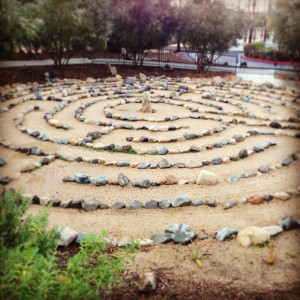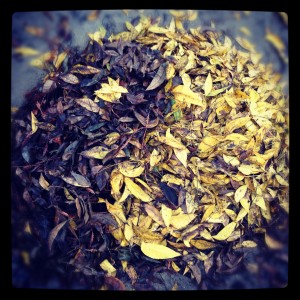What do sustainability and yoga have in common?
A yoga practice has to be sustainable. I’d burn out on yoga if I went all out everyday. But mindfully paying attention to my body, I can listen to what it needs each day. A practice in yoga that is mindful and gentle helps us become stewards of our bodies, taking care of our bodies so that our bodies continue to take care of us.
The same is true with the environment. We cannot take, take, take, take from the environment and expect that it is infinite in its resources – this would be like holding chaturanga for the entire daily practice in improper alignment for a year straight and expecting to not have issues with your arms and elbows and imbalances in the rest of your body. Over time, misuse and lack of stewardship will take a toll.

Treat the tiny blue dot that is the Earth as you treat your body in a yoga practice. And if you don’t treat your body well during your practice, please do! Because how you treat yourself is how you treat the world around you and vice versa.
Another way sustainability is like yoga is that your voice and your experience matters. A teacher can tell you how to “properly” get in and out of a pose and hold a pose, but there is no “proper” when it comes to the uniqueness of your body and what it needs. As you become more aware of your body, you become more in tune with those needs. What matters is you giving yourself the space and attention you need to practice safely and mindfully in your own body. And if a teacher directs you to move or go deeper in a pose, and it isn’t right for your body, then don’t.
The same is true for the environment. When you start to pay attention to your outside environment, you start to see the ways that you directly impact it. Whether it’s feeding birds – you are directly nourishing them. Or whether you put down rat poison which kills off rats and subsequently poisons the beautiful bird or prey predators that eat the rats, hurting the entire ecosystem. When you start to see these impacts, you can make a more thoughtful decision to treat the world around you with care, regardless of the actions or lack of actions by those around you.
This brings me to the ever difficult but ever necessary yogic principle, Svadhyaya, which is a niyama (one of the 8 limbs of yoga). B.K.S. Inyengar defines svadhyaya in his “Light on Yoga” as follows: “Sva means self and adhyaya means study or education. Education is the drawing out of the best that is within a person. Svadhyaya, therefore, is the education of the self.” As part of svadhyaya, Inyengar goes on to write that you start “to realize that all creation is meant for bhakti (adoration) rather than for bhoga (enjoyment), that all creation is divine, that there is divinity within himself and that the energy which moves him is the same that moves the entire universe.”
 Don’t look away. Keep learning and keep pushing yourself. Growth comes slowly after continual consistent sustainable practice. This attention to the present moment and to self-study is a practice in yoga. So even if you don’t make it to the yoga class, guess what, you’re practicing 😉
Don’t look away. Keep learning and keep pushing yourself. Growth comes slowly after continual consistent sustainable practice. This attention to the present moment and to self-study is a practice in yoga. So even if you don’t make it to the yoga class, guess what, you’re practicing 😉
But with yoga there are those immediate benefits after a practice that keep you practicing for your long term health.
The planet is on a larger scale, so it takes a lot longer to see the impacts we have, good or bad. But they are there and they impact us all. I think precisely because it is so huge, we can tend to freeze up and make light of the situation or ignore it completely. Because it’s scary! A reaction of feeling overwhelmed when it comes to the crisis our planet is facing right now is extremely logical and understandable. To walk around just feeling overwhelmed at the problem is not a sustainable way to live your life.
But there is another way. One I’m trying to learn every day. Believe me, I live in Los Angeles, there is a lot of waste in my life, primarily centered around driving and burning fossil fuels in doing so.
Awareness, mindfulness, and staying present with it – that’s my aim. A changing climate is not going away just because I don’t choose to look at it.
But a miraculous, or rather perfectly natural, thing that happens when I stay aware of it is that creative opportunities arise to change my habits to ones with a more positive impact. When I started noticing that I was throwing away plastic disposable utensils and knew they were ending up in a landfill for the next few hundred years, I realized I could just carry a set of compact camping utensils to prevent creating unnecessary waste.

Your creativity will find the benefits when you train your mind to look for them.
Next time the impulse comes on to laugh off how serious the changing climate is with friends or joke that it’s the end of the world, or off-handedly state that the extreme weather you are experiencing is a result of “eh, climate change,” continue that phrase, “…climate change, and what can I do about it now?”
It’s really a call to action. Keep asking, and the answers will come to you, just as you keep practicing and the poses come to you.
You don’t have to do it alone either. Take that powerful voice of yours and use that voice to implement change in your neighborhood and beyond to affect policy by voting and signing petitions to make your community more sustainable. Much of the time we may not feel empowered to speak up because we don’t think things will change. But I know through the practice of yoga, I’ve become a lot more centered in my voice. I have learned what feels safe, strong and balanced in my body, and I have become more acutely aware of what does or doesn’t feel safe and balanced in the world around me. That helps me to know that I can speak up to create an environment that does feel balanced.
 Jessica Spotts is a nationally certified Yoga instructor at the 500-Hour Level with the Yoga Alliance. She received her 500-hour certification in Santa Monica, CA. She teaches in the style of Vinyasa Flow and Hatha. She believes that yoga can be for everyone, using breath, postures, and philosophy to bring mindfulness/awareness to our habits, both physical and mental. She is passionate about yoga, the environment, and the ability for yoga to awaken a sense of freedom and action in one’s life. She has taught and worked with special populations including children and at-risk/underserved youth through volunteer work with Uprising Yoga at Los Angeles Central Juvenile Hall.
Jessica Spotts is a nationally certified Yoga instructor at the 500-Hour Level with the Yoga Alliance. She received her 500-hour certification in Santa Monica, CA. She teaches in the style of Vinyasa Flow and Hatha. She believes that yoga can be for everyone, using breath, postures, and philosophy to bring mindfulness/awareness to our habits, both physical and mental. She is passionate about yoga, the environment, and the ability for yoga to awaken a sense of freedom and action in one’s life. She has taught and worked with special populations including children and at-risk/underserved youth through volunteer work with Uprising Yoga at Los Angeles Central Juvenile Hall.
